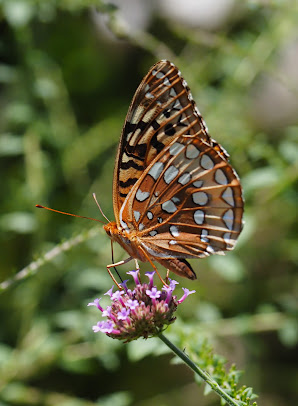Tuesday, August 16, 2022
The Elusive Monarch Butterfly
Monday, August 15, 2022
Magnolia, Wasp and Nursery
The 'Little Gem' Magnolia continues to bloom through the summer. Most of them are far above my height, but this one is within reach. The shape of its inner parts continues through to the seed pods that drop all over. Aidan has decided that they are great fun for chewing, while I fear he will swallow one.
On the other side of the yard a Great Black Wasp is busy collecting nectar from the cat mint, Calamintha nepeta "Monrose White'. They are nectar and pollen eaters. I often see these among the flowers, and am pleased to learn that they are quite beneficial. They burrow in the soil and lay their eggs next to a cricket, grasshopper or Katydid carcass, keeping those chewers under control.
Earlier I had a picture of the caterpillar for a Pipevine Swallowtail Butterfly. If you look closely you will find at least four of them in this picture. At the top is a very large one chewing on a Aristolochia fimbriata (White Veined Dutchman’s Pipe) leaf. Stupid me, I had not made the connection between the vine and the butterfly! This is their favored food, and the flowerbed is full of the vines. Therefore, I keep seeing lots of these beautiful swallowtails in the garden. And the vines are still growing, though not as large as usual.Sunday, August 14, 2022
Ongoing Search
The search for new varieties of butterflies continues. This appears to be a Great Spangled Fritillary based on the pictures of the top of the wings, and the underside of the wings, as seen below.
I have waited a few days before putting up these photos, hoping I could get a clearer picture of the top of the wings. But this is the only one that I have been able to get on the camera.
I have seen one other orange butterfly, which I believe was a Monarch. However, it quickly moved through the garden, and was gone by the time I got back with the camera. Often the Monarch butterflies return in the autumn on their migration back South. I have milkweed plants waiting their arrival.
Finally, here is one of many Praying Mantises standing guard in hopes of catching one of the dwindling number of butterflies.
Monday, August 8, 2022
Proboscis in Action
One of the tricks the Olympus OM-D Mark III is shooting a sequence of fast shots. The camera will catch a series of moments without the human eye/response needing to trip the shutter at the perfect time.
Here a Fiery Skipper is unrolling its proboscis to feed on the nectar of the Verbena bonariensis. The first shot shows it rolled up in a tight spiral.
It starts uncurling the proboscis.Further and further out.
Sunday, August 7, 2022
Butterfiles and Spiders
I recently traded in my beloved Nikon camera and three lenses for a partial payment on a new Olympus 12-100mm Pro
Zoom lens for the OM-D E-M1 Mark III. As I experiment with the new lens, I am also quickly settling into how it works.
I am moving on to the smaller butterflies, much easier to get with the wide zoom range and crystal clear lens. This is a Salt Marsh Skipper, only about an inch long. I actually confirmed its correct name with a different shot, but this is the best portrait.
I call this my Menage a Trois picture. The two Fiery Skippers on the left were literally hooked up, doing their thing when the third Skipper started to attack them. The attacker appears to be a male, going after the other male on the right side. Maybe butterflies get jealous?This Argiope aurantia spider has many common names, as simple as Yellow Garden Spider and can be found across North and Central America. This one has captured a Pipevine Swallowtail Butterfly in its web under the tree in the middle of the labyrinth. There were also other prey in its sprawling web. Enjoying nature is not for the soft hearted.
Wednesday, August 3, 2022
More Butterflies
There are also many Zebra Swallowtails, which prefer the verbena over the Agapanthus. Many of these are smaller than the other Swallowtails.
Finally there are the Sleepy Orange butterflies which hang out on the Zinnias. I don't know why they are called "sleepy" because when they are flying they move very fast. I cannot get a picture of them with their wings open. But then my reference website to identify Maryland butterflies only has this kind of shot.
I am still trying to get a few others flying around.

















